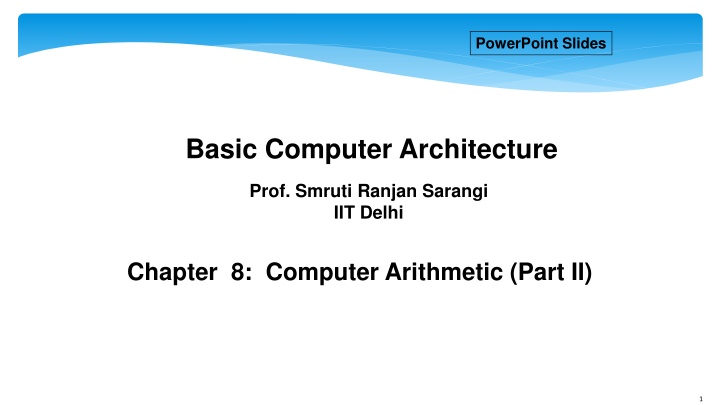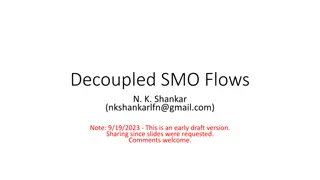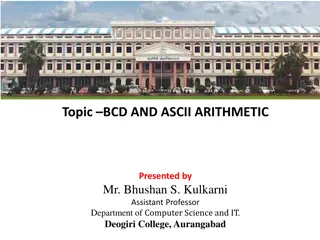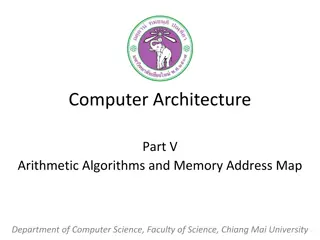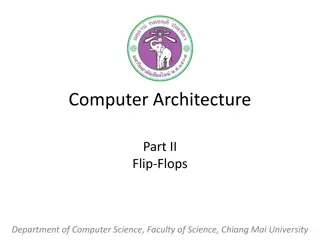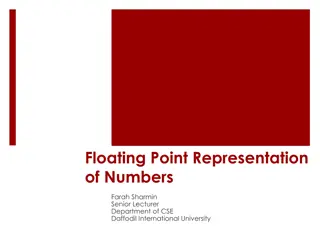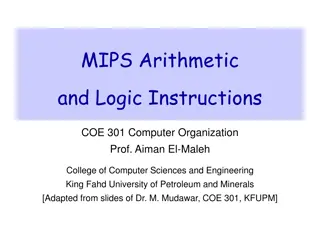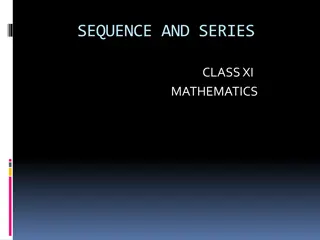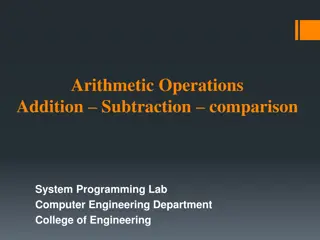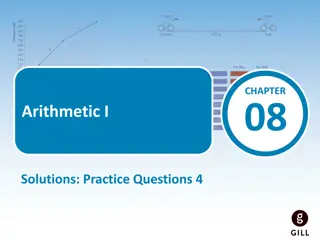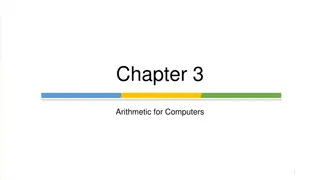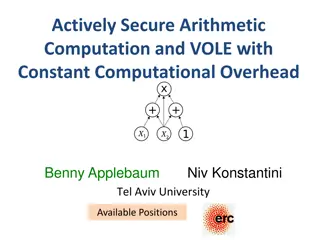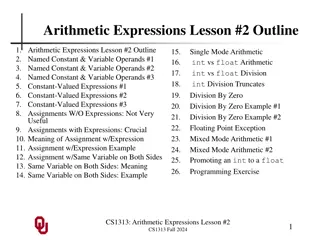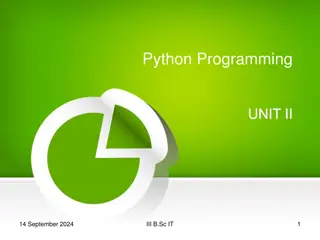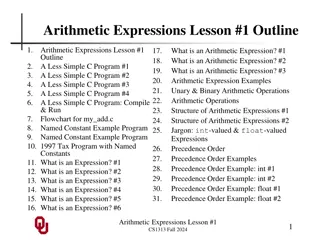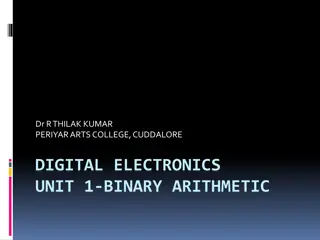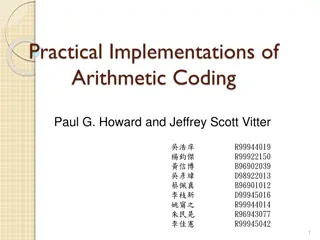Computer Arithmetic in Basic Computer Architecture
This presentation delves into the realm of computer arithmetic in basic computer architecture, covering essential topics such as addition, multiplication, division, and floating-point operations. The slides illustrate techniques for integer division and the reduction of division problems, along with iterative and restoring division algorithms. The content also provides insights into how problems can be effectively reduced and tackled iteratively to achieve accurate division results.
Download Presentation

Please find below an Image/Link to download the presentation.
The content on the website is provided AS IS for your information and personal use only. It may not be sold, licensed, or shared on other websites without obtaining consent from the author.If you encounter any issues during the download, it is possible that the publisher has removed the file from their server.
You are allowed to download the files provided on this website for personal or commercial use, subject to the condition that they are used lawfully. All files are the property of their respective owners.
The content on the website is provided AS IS for your information and personal use only. It may not be sold, licensed, or shared on other websites without obtaining consent from the author.
E N D
Presentation Transcript
PowerPoint Slides Basic Computer Architecture Prof. Smruti Ranjan Sarangi IIT Delhi Chapter 8: Computer Arithmetic (Part II) 1
2nd version www.basiccomparch.com Download the pdf of the book videos Slides, software, solution manual Print version (Publisher: WhiteFalcon, 2021) Available on e-commerce sites. The pdf version of the book and all the learning resources can be freely downloaded from the website: www.basiccomparch.com
Outline Addition Multiplication Division Floating Point Addition Floating Point Multiplication Floating Point Division 3
Integer Division Let us only consider positive numbers N = DQ + R N Dividend D Divisor Q Quotient R Remainder Properties [Property 1:] R < D, R >= 0 [Property 2:] Q is the largest positive integer satisfying the equation (N = DQ +R) and Property 1 4
Reduction of the Divison Problem ? = ?? + ? = ??1 ? 1+ ???2? 1+ ? ? ???2? 1 ? ? = ?? + ? = ??1 ? 1 + ? ? We have reduced the original problem to a smaller problem 5
How to Reduce the Problem We need to find Qn We can try both values 0 and 1 First try 1 If : N D2n-1 >= 0, Qn = 1 (maximize the quotient) Otherwise it is 0 Once we have reduced the problem We can proceed recursively 6
Iterative Divider Divisor(D) (U-D) V U Initial: V holds the dividend (N), U = 0 7
Restoring Division Algorithm 3: Restoring algorithm to divide two 32 bit numbers Data: Divisor in D, Dividend in V, U = 0 Result: U contains the remainder (lower 32 bits), and V contains the quotient i 0 for i < 32 do i i + 1 /* Left shift UV by 1 position UV UV << 1 U U - D if U 0 then q 1 end else U U + D q 0 end /* Set the quotient bit LSB of V q end */ */ 8
Example Dividend (N) 00111 Divisor (D) 0011 U V 00000 0111 beginning: 00000 111X after shift: 1 end of iteration: 00000 1110 00001 110X after shift: 2 end of iteration: 00001 1100 00011 100X after shift: 3 end of iteration: 00000 1001 001X 00001 after shift: 4 end of iteration: 00001 0010 Quotient(Q) 0010 Remainder(R) 0001 9
Restoring Division Consider each bit of the dividend Try to subtract the divisor from the U register If the subtraction is successful, set the relevant quotient bit to 1 Else, set the relevant quotient bit to 0 Left shift 10
Proof Let us consider the value stored in UV (ignoring quotient bits) After the shift (first iteration) UV = 2N After line 5, UV contains UV 2nD = 2N 2nD = 2 * (N 2n-1 D) If (U D) >= 0 N' = N 2n-1D. Thus, UV contains 2N' 11
Proof - II If (U D) < 0 We know that (N = N') Add D to U Add 2nD to UV partial dividend = 2N = 2N' In both cases The partial dividend = 2N' After 32 iterations V will contain the entire quotient 12
Proof - III At the end, UV = 232 * N32 (Ni is the partial dividend after the ith iteration) N31 = DQ1 + R N31 DQ1 = N32 = R Thus, U contains the remainder (R) 13
Time Complexity n iterations Each iteration takes log(n) time Total time : n log(n) 14
Restoring vs Non-Restoring Division We need to restore the value of register U Requires an extra addition or a register move Can we do without this ? Non Restoring Division 15
Algorithm 4: Non-restoring algorithm to divide two 32 bit numbers Data: Divisor in D, Dividend in V, U = 0 Result: U contains the remainder (lower 32 bits), and V contains the quotient i 0 for i < 32 do i i + 1 /* Left shift UV by 1 position UV UV << 1 if U 0 then U U D end else U U + D end if U 0 then q 1 end else q 0 end /* Set the quotient bit lsb of V q end if U <0 then U U + D end */ */ 16
Dividend (N) 00111 Divisor (D) 0011 V U 00000 0111 beginning: 00000 111X after shift: 1 end of iteration: 11101 1110 11011 110X after shift: 2 end of iteration: 11110 1100 11101 100X after shift: 3 end of iteration: 00000 1001 00001 001X after shift: 4 end of iteration: 11110 0010 U V 0001 0010 end (U=U+D): Quotient(Q) 0010 Remainder(R) 0001 17
Idea of the Proof Start from the beginning : If (U D) >= 0 Both the algorithms (restoring and non-restoring) produce the same result, and have the same state If (U D) < 0 We have a divergence In the restoring algorithm value(UV) = A In the non-restoring algorithm value(UV) = A - 2nD 18
Proof - II In the next iteration (just after the shift) Restoring : value(UV) = 2A Non - Restoring : value(UV) = 2A - 2n+1D If the quotient bit is 1 (end of iteration) Restoring : Subtract 2nD value(UV) = 2A - 2nD Non Restoring : Add 2nD value(UV) = 2A 2n+1D + 2nD = 2A - 2nD 19
Proof - III If the quotient bit is 0 Restoring partial dividend = 2A Non restoring partial dividend = 2A 2nD Next iteration (if quotient bit = 1) (after shift) Restoring : partial dividend : 4A Non restoring : partial dividend : 4A 2n+1D Keep applying the same logic . 20
Outline Addition Multiplication Division Floating Point Addition Floating Point Multiplication Floating Point Division 21
Adding Two Numbers (same sign) Normalised form of a 32 bit (normal) floating point number. A = ( 1)S P 2E bias, (1 P < 2, E Z, 1 E 254) (7.22) Normalised form of a 32 bit (denormal) floating point number. A = ( 1)S P 2 126, (0 P < 1) (7.23) Symbol S P M E Z Meaning Sign bit (0(+ve), 1(-ve)) Significand (form: 1.xxx(normal) or 0.xxx(denormal)) Mantissa (fractional part of significand) (exponent + 127(bias)) Set of integers Recap : Floating Point Number System 22
Addition Add : A + B Unpack the E fields EA , EB Let the E field of the result be EC Unpack the significand (P) P contains 1 bit before the decimal point, 23 mantissa bits (24 bits) Unpack to a 25 bit number (unsigned) W Add a leading 0 bit, 24 bits of the signficand 23
Addition - II With no loss of generality Assume EA >= EB Let significands of A and B be PA and PB Let us initially set W unpack (PB) We make their exponents equal the right by (EA EB) positions ? = ? ?? ?? ? = ? + ?? and shift W to 24
Renormalisation Let the significand represented by register, W, be PW There is a possibility that PW >= 2 In this case, we need to renormalise W W >> 1 EA EA + 1 The final result Sign bit (same as sign of A or B) Significand (PW), exponent field (EA) 25
Example Example: Add the numbers: 1.012 * 23 + 1.112 * 21 Answer: The decimal point in W is shown for enhancing readability. For simplicity, biased notation not used. 1. A = 1.01 * 23and B = 1.11 * 21 2. W = 01.11 (significand of B) 3. E = 3 4. W = 01.11 >> (3-1) = 00.0111 5. W + PA = 00.0111 + 01.0100 = 01.1011 6. Result: C = 1.011 * 23 26
Example - II Example: Add : 1.012 * 23 + 1.112 * 22 Answer: The decimal point in W is shown for enhancing readability. For simplicity, biased notation not used. 1. A = 1.01 * 23and B = 1.11 * 22 2. W = 01.11 (significand of B) 3. E = 3 4. W = 01.11 >> (3-2) = 00.111 5. W + PA = 00.111 + 01.0100 = 10.001 6. Normalisation: W = 10.001 >> 1 = 1.0001, E = 4 7. Result: C = 1.0001 * 24 27
Rounding Assume that we were allowed only two mantissa bits in the previous example We need to perform rounding Terminology : Consider the sum(W) of the significands after we have normalised the result W (P + R) * 2-23 (R < 1) 28
Rounding - II P represents the significand of the temporary result R (is a residue) Aim : Modify P to take into account the value of R Then, discard R Process of rounding : P P' 29
IEEE 754 Rounding Modes Truncation P' = P Example in decimal : 9.5 9, 9.6 9 Round to + P' = P +R Example in decimal : 9.5 10, -3.2 -3 30
IEEE 754 Rounding - II Round to - P' = P+R Example in decimal : 9.5 9, -3.2 -4 Round to nearest P' = [P + R] Example in decimal : 9.4 9 , 9.5 10 (even) 9.6 10 , -2.3 -2 -3.5 -4 (even) 31
Rounding Modes Summary Rounding Mode Condition for incrementing the significand Sign of the result (+ve) Sign of the result (-ve) Truncation Round to + Round to Round to Nearest R > 0 R > 0 (R > 0.5)||(R = 0.5 lsb(P) = 1) (R > 0.5)||(R = 0.5 lsb(P) = 1) (logical AND), R (residue) 32
Implementing Rounding We need three bits lsb(P) msb of the residue (R) r (round bit) OR of the rest of the bits of the residue (R) s (sticky bit) Condition on Residue R > 0 R = 0.5 R > 0.5 r (round bit), s(sticky bit) Implementation r s = 1 r s = 1 r s = 1 33
Renormalisation after Rounding In rounding : we might increment the significand We might need to renormalise After renormalisation Possible that E becomes equal to 255 In this, case declare an overflow 34
Addition of Numbers (Opposite Signs) C = A + B Same assumption EA >= EB Steps Load W with the significand of B (PB) Take the 2's complement of W (W = -B) W W >> (EA EB) W W + PA If (W < 0) replace it with its 2's complement. Flip the sign of the result. 35
Addition of Numbers (Opposite Signs)-II Normalise the result Possible that W < 1 In this case, keep shifting W to the left till it is in normal form. (simultaneously decrement EA) Round and Renormalise 36
C = A + B Y A=0? C=B N N W < 0? Y B=0? C=A Y N W - W (2's complement) Swap A and B such that E <= EA B S = S W P >> (EA EB) B EA, S Normalize W and update E Y Overflow or underflow? E sign(A) Report N Y Y Overflow or underflow? sign(A) = sign(B)? Construct C out of W, E, and S N Report N W - W (2's complement) Round W C W W + P A Normalize W and update E 37
Outline Addition Multiplication Division Floating Point Addition Floating Point Multiplication Floating Point Division 38
Multiplication of FP Numbers Steps E EA + EB- bias W PA * PB Normalise (shift left or shift right) Round Renormalise 39
C = A * B Y A=0? C=0 Normalize W and update E N Y B=0? C=0 N Y Overflow or underflow? sign(A) sign(B) S Report N E E + E - bias A B Round W Construct C out of W, E, and S Normalize W and update E Y Overflow or underflow? C N Report Y Overflow or underflow? P A P B W * Report N 40
Outline Addition Multiplication Division Floating Point Addition Floating Point Multiplication Floating Point Division 41
Simple Division Algorithm Divide A/B to produce C There is no notion of a remainder in FP division Algorithm E EA EB + bias W PA / PB normalise, round, renormalise Complexity : O(n log(n)) 42
Goldschmidt Division Let us compute the reciprocal of B (1/B) Then, we can use the standard floating point multiplication algorithm Ignoring the exponent Let us compute (1/PB) If B is a normal floating point number 1 <= PB < 2 PB = 1 + X (X < 1) 43
Goldschmidt Division - II 1 ?? 1 = ??= 1 + ?,0 < ? < 1 1 + ? 1 ? = 1 ?,? < 1 = 1 + 1 ? 1 2 ? =1 2 = 1 1 ? 1 1 ? ( ? =? 2 =1 2,? <1 2 2) 44
1 + ? 1 ?2 1 + ? (1 + ?2) 1 ?4 = 1 + ? 1 + ?2 (1 + ?16) 1 ?32 1 + ? 1 + ?2 (1 + ?16) 1 1 ?= = = No point considering Y32 Cannot be represented in our format 45
Generating the 1/(1-Y) 1 + ? 1 + ?2 (1 + ?16) We can compute Y2 using a FP multiplier. Again square it to obtain Y4, Y8, and Y16 Takes 4 multiplications, and 5 additions, to generate all the terms Need 4 more multiplications to generate the final result (1/1-Y) Compute 1/PB by a single right shift 46
GoldSchmidt Division Summary Time complexity of finding the reciprocal (log(n))2 Time required for all the multiplications and additions (log(n))2 Total Time : (log(n))2 47
Division using the Newton Raphson Method Let us focus on just finding the reciprocal of a number Let us designate PB as b (1 <= b < 2) Aim is to compute 1/b Let us create a function f(x) = 1/x b f(x) = 0, Problem of computing the reciprocal when x = 1/b same as computing the root of f(x) 48
Idea of the Method Start with an arbitrary value of x x0 Locate x0 on the graph of f(x) Draw a tangent to f(x) at (x0 , f(x0)) Let the tangent intersect the x axis at x1 Draw another tangent at (x2, f(x2)) Keep repeating Ultimately, we will converge to the root 49
Newton Raphson Method x0,f(x0) f(x) x1,f(x1) root x2 x0 x1 x 50
